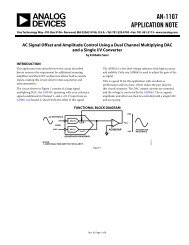ee pulse - EEWeb
ee pulse - EEWeb
ee pulse - EEWeb
You also want an ePaper? Increase the reach of your titles
YUMPU automatically turns print PDFs into web optimized ePapers that Google loves.
INTERVIEW<br />
simple. Power and ground. Check<br />
the voltage on every node/pin. Don’t<br />
assume anything. Once the basics/<br />
bias checks out, start varying over<br />
ranges. Do min and max input get<br />
expected output? Then follow the<br />
signal through the system.<br />
What has b<strong>ee</strong>n your favorite<br />
project?<br />
My favorite project was constructing<br />
a horn antenna to be used at the<br />
“Big Dish” on Stanford University’s<br />
campus. The operating frequency<br />
was 330MHz, so the horn was<br />
about the size of a coffin. I soldered<br />
copper clad pieces together and<br />
built a wooden exoskeleton for<br />
support. It was awesome to s<strong>ee</strong> the<br />
mathematics come to life, to test the<br />
antenna response in a warehouse at<br />
SRI, and then to mount it on that big,<br />
beautiful dish and s<strong>ee</strong> it work! Well,<br />
it worked until a bird decided that<br />
it was a wonderful place to build a<br />
nest.<br />
Do you have any note-worthy<br />
engin<strong>ee</strong>ring experiences?<br />
I’m particularly proud of the Test<br />
Development Engin<strong>ee</strong>ring Program<br />
I championed at San Jose State<br />
University. After noticing that<br />
electrical engin<strong>ee</strong>ring students<br />
were finding jobs as apps, test and<br />
product engin<strong>ee</strong>rs, I joined with a<br />
team of folks from Agilent, National<br />
Semiconductor, Teradyne and<br />
Intersil to put together a program<br />
to teach skills n<strong>ee</strong>ded for these<br />
areas. Students spent the spring<br />
semester learning lab techniques<br />
like measurement and soldering.<br />
They designed a PCB to test an IC<br />
and presented their work to a panel<br />
from the supporting companies. In<br />
the summer they had internships<br />
with the sponsors. In the fall, they<br />
returned to school and proc<strong>ee</strong>ded<br />
in their work—this time on ATEs.<br />
Along the way, they learned a<br />
lot about the semiconductor<br />
industry and where they would fit<br />
in. Every student got a job. They<br />
even nominated me for an IEEE<br />
certificate of appreciation. Cool<br />
stuff.<br />
If I was to tell you some of the cool<br />
things I work on now, it would break<br />
customer confidentiality. Let’s just<br />
The global work<br />
force is adjusting<br />
its footprint.<br />
While it might be<br />
advantageous to<br />
use cheaper labor,<br />
the time, cultural<br />
and communication<br />
differences are a big<br />
stumbling block for<br />
projects that span<br />
multiple continents.<br />
say that it’s fun to walk around Best<br />
Buy and s<strong>ee</strong> all of the products that<br />
use an IC from Intersil—especially<br />
one of the light sensors.<br />
How is academia different<br />
than industry?<br />
Huge difference. From the students<br />
perspective, you learn a lot of<br />
math in college. You can solve<br />
KVL and KCL with Thevenin and<br />
Norton equivalents. You can take<br />
derivatives with respect to time<br />
and to voltage. In industry, the<br />
derivatives are with respect to cost<br />
and to customer interest. It’s hard<br />
to put those into matrices (yet MBAs<br />
and economists do it all the time).<br />
From a professor standpoint, you<br />
are trying to get as many students<br />
through the system as possible.<br />
There is so much that could be<br />
taught, but there are also so many<br />
regulations about teaching (think<br />
ABET accredited). Many professors<br />
teach the same material because it<br />
is approved. It’s a lot of work to put<br />
a class together and it is too easy to<br />
use the same material “one more<br />
time”. Besides, the point of school<br />
is to learn the basics, right? The<br />
basics don’t change much. Still,<br />
the motivation and end goals do<br />
change. Our university classrooms<br />
are not at the forefront of technology.<br />
(One could argue that the research<br />
labs at a university house the<br />
forefront of technology. Yes, a ittybitty<br />
slice of it.) Remember, though,<br />
that engin<strong>ee</strong>ring is growing and<br />
changing every day. University<br />
curriculums, therefore, must<br />
theoretically teach more and more<br />
each year. Students don’t stay in<br />
school longer, so sacrifices have to<br />
be made. Often that means tough<br />
choices.<br />
I, personally, prefer the “real world”<br />
where the technological innovation<br />
creates a product or device that<br />
enables product differentiation or<br />
<strong>EEWeb</strong> | Electrical Engin<strong>ee</strong>ring Community Visit www.<strong>ee</strong>web.com 6<br />
FEATURED INTERVIEW















